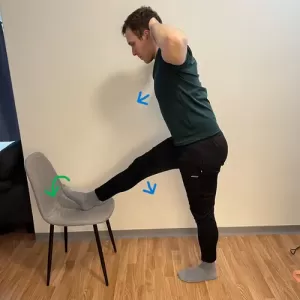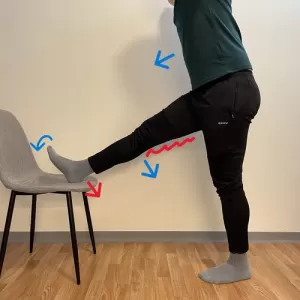Mastering the Biceps Femoris Stretch: A Comprehensive Guide to Improving Flexibility and Preventing Injury
The biceps femoris muscle is located in the back of your thigh and has two main functions: knee flexion and hip extension.
Knee flexion – bringing your foot towards the buttocks, such as when doing a leg curl exercise.
Hip extension – straightening the leg behind your body, such as when performing a leg press exercise.
Additionally, biceps femoris muscle helps with outward rotating your leg (external rotation).
Jumping or running can place a lot of stress on biceps femoris since your legs are often behind your body and bent at knees. (the exact movements biceps femoris is responsible for – knee flexion and hip extension).
Learning how to stretch biceps femoris correctly will help you keep this muscle safe and healthy even when you’re under hard jumping/running training.
Here are my thoughts on biceps femoris stretch guide.
* Stretching equipment that I find helpful to stretch hamstrings muscles.
Stretches for Biceps Femoris
Perform stretches in order as presented here to relieve tightness in biceps femoris and to increase range of motion of knee extension.
Dynamic Biceps Femoris Stretch
- Start by standing upright with one foot placed on a chair
- Rotate your leg slightly inward, keeping your knee slightly bent
- Place your hands behind your head
- Gently push your upper body forward, then return to the starting position
- Repeat this movement 10 times
*With internally rotating your leg you target more biceps femoris, and less semitendinosus and semimembranosus muscles.
Standing Passive Biceps Femoris Stretch
- Begin by standing upright with one foot placed on a chair
- Rotate your leg slightly inward, keeping your knee slightly bent
- Place your hands behind your head
- Gently push your upper body forward until you feel a pleasant stretch in your hamstrings
- Hold this position for 30 seconds.
*Same position as with dynamic stretch, but perform with static hold instead
Supine Biceps Femoris Stretch With Stretching Strap
- Lie down on your back and place a stretching strap under one foot.
- Raise your leg as much as you can.
- Gently rotate your leg inward and pull the stretching strap towards your body while keeping your knee extended.
- Hold the stretch for 30 seconds
PNF Contract-Relax Stretching Technique for Biceps Femoris
Starting position – Standing with one foot on a chair. Rotate your leg internally.
Stretching – Push forward with your upper body, stretching biceps femoris passively. Hold for 10s.
Contract – At the end of a stretching phase, contract your biceps femoris muscle by pushing downward with your heel. (without moving your leg) Hold for 6s.
Repeat the whole process five times more.
blue – stretching phase
red – contract biceps femoris phase
Tips and Safety Precaution when Stretching Biceps Femoris
- Don’t bounce into a stretch
- Focus on holding your leg rotated inward during stretches
- When performing PNF technique, don’t contract your hamstring muscles with maximal strength, 20% of max will do the job.
Continue reading:
References
- Hamstring Stretch – Mayo Clinic
- Hamstring Injury – Mayo Clinic


